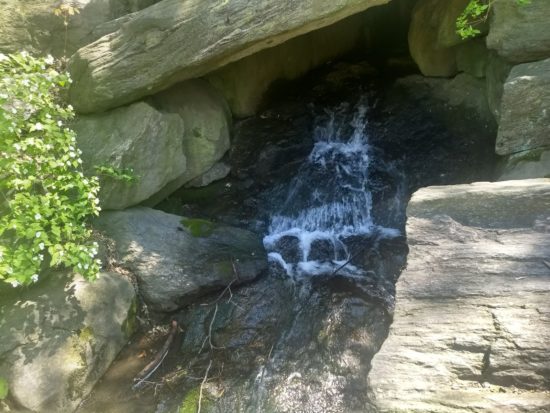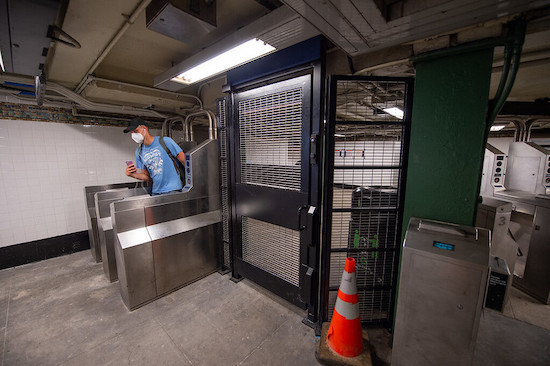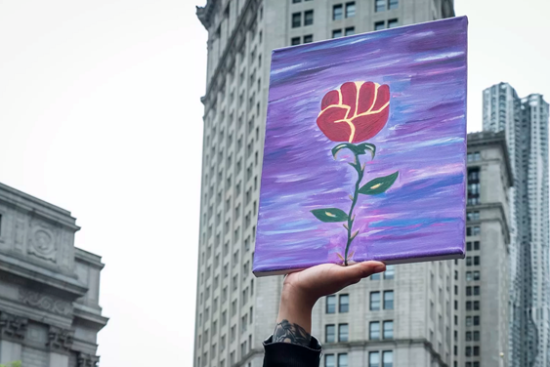By Marjorie Cohen
The fifth in our 7 Walks in 7 Days around the Upper West Side heads to a special part of Central Park.
Glen Span Arch, a short walk east from the Central Park entrance at West 103rd Street
Olmstead and Vaux’s plan for Central Park divided the park in two–the southern end was designed to be pastoral and the northern end was to be rustic and rugged. Enter the park at 103rd Street and you’ll be right at the spot where pastoral meets rustic. Walk past an expanse of lawns that slope down to a pond (called The Pool) that is circled by trees, including some beautiful full-grown weeping willows. (How about a picnic on the banks of The Pool after your walk?)
Keep walking east and you’ll come to the stone Glen Spa Arch. The footpath under the arch marks the beginning of the 40-acre North Woods.
The arch, built in 1865, stands next to Montayne’s Rivulet, a stream that was there when Olmstead and Vaux started their planning. But, since these two guys wanted things the way they wanted them, the stream had to be rerouted to fit into their plan. Christopher Gray, who wrote about the history of the city for the New York Times, called the re-design “a masterpiece of landscape manipulation.”
Some of the best surprises that the two designers created when they altered the course of the stream are the cascades of water that tumble down the rocks alongside its banks. I’ve always thought of them as waterfalls but that’s a bit of hyperbole; it seems that cascades is a more accurate term. Whatever they’re called, they’re a wonderful sight to see. Walk past the stream, under the bridge, and into a lush forest setting and you’ll forget that you’re in one of the largest cities in the world.
Under the bridge there’s a niche that once held a bench and a grotto, a decorative element that was popular in the mid-1900s and, according to Cynthia Brenwall’s book on Central Park was meant to make walkers think that they were strolling on the grounds of an English country house. It gave them the illusion that they were “stumbling on ancient ruins or discovering a hidden treasure.”
There is a hidden treasure here: it’s the entire span of the North Woods.










Thank you for this! I recently discovered the waterfall (oops cascade) during the lockdown, as I took my daily walk in the Park, venturing further north than usual.
Martha, same here! I know the south end of the park like the back of my hand, but felt like I discovered a whole new world by going all the way up to the north woods. Beautiful.
My favorite part of the park!
That “lesser-known” northwestern part of C.P. also features:
1. Conservatory Garden(s), three beautiful formal gardens (English, French, and Italian) beautifully maintained by Central Park Conservancy and a colorful riot of seasonal blossoms (esp. the Tulips in early Spring);
2) the vast expanse of The Harlem Meer, with the buildings of Harlem forming a backdrop;
3) and Maoz, a neat takeout-food place, and lots of nearby benches to sit-eat-and-watch.
AND, it’s near Museum of the City of New York and El Museo del Barrio (both currently closed b/c the pandemic…but hopefully will re-open)
Northeastern not northwestern. Let’s not lead interested people astray. The Conservatory Gardens face Fifth Avenue.
I remember the first time I discovered the cascade, the grotto tunnel and the north woods – a little hike that led me to the Lasker Rink. This was before the resurgence of the manhattan valley area. That part of the park was not heavily used and friends thought I was crazy for wandering around there. I never encountered another human being in the North Woods back then. Not so anymore….
On a similar note, I remember years ago walking along the Hudson river north of the tennis courts before the city cleared the area for the bike path. It was likewise empty, a forested trail, and only a few people knew about the secret stone jetties that shot out into the river where you could sit and reflect/read in silence and solitude. Not so anymore…
Another wonderful piece by Marjorie Cohen–thank you! I am eager to revisit this breathtakingly beautiful, less traveled area of the park, especially as the summer heat and humidity take hold!
And hats off to the great West Side Rag for this delightful and original “7 Walks in 7 Days” series!
It’s not hidden if you live nearby. We are so fortunate to live close to the most beautiful part of the park.
I have always wondered what that niche originally was. Now I know. Thanks!
Thanks for the great Walks series! New or known, each one a gem of possibility for the next outdoor opportunity.
I used to love walking in these areas until The Conservatory fenced everything off. It used to be “rustic and rugged” as envisioned.
NOW it feels like a tree museum.
Re: “until The Conservatory fenced everything off….”
1. It’s the Central Park CONSERVANCY (CPC)…not “The Conservatory” that maintains C.P.;
2. IF something IS fenced off there is probably a very good reason that CPC did so. They are NOT the enemy! Without their constant care our park would still be an urban-dust-bowl.
3. No, I have no vested interest in CPC, but I DO donate to them each year, as do many others.
YES, that IS a suggestion
When I went to Jr and Sr High School, lower Central Park was our “campus.” I now live across from Upper CP. You are so right!! The park went into serious decline, in part due to NYC’s financial issues. I truly believe The Conservancy saved it. I contribute as much as I can annually to them and purchased a paver stone near the reservoir in memory of my brother.
We have always wondered about the cascades. Are they natural streams, and if so, where is the source of the water?
If not, is there a pump somewhere?
The included photo is a bit deceptive, I think. It’s of the cascade along the walkway that supplies water to The Pool, not the cascade that empties from The Pool into the stream that goes under the arch into the Loch.
Speaking of which, I’d love to know the origins of the cascade that *is* in the photo. I’ve always been curious where the water comes from!